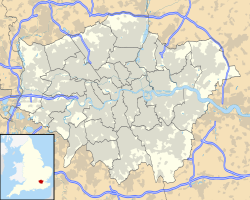Royal Docks
Location of the Royal Docks in Greater London |

The Royal Docks consist of three docks in the east end of London - the Royal Albert Dock , the Royal Victoria Dock and the King George V Dock . The correct name is Royal Group of Docks to distinguish them from the Royal Dockyards . Their name is derived from their naming after members of the royal family and not because they belonged to the crown. The three port basins together with a water area of 1.0 km² and a total area of 4.5 km² form the largest contiguous port facilities in the world. This area corresponds to that of the entire city center of London from Hyde Park to Tower Bridge .
history
The three docks were completed between 1855 and 1921 and are located in the boroughs of East Ham and West Ham (now the London Borough of Newham ). The Royal Victoria Dock and Royal Albert Dock were built by the London & St. Katharine Docks Company to serve as anchorages for large ships that could not go any further upstream. They enjoyed great economic success and in the first half of the 20th century they became London's most important port facilities. With their rows of huge grain silos and cold stores along the quays, they were particularly used for the import and unloading of food. Hundreds of passenger and cargo ships could dock at the same time on the 19.3 km quay length of the huge harbor basin. After the opening of the Royal Albert Dock in 1880, which provided a connection between the Royal Docks and Gallion's Reach of the Thames , 17.7 km below Tower Bridge, the competitor East & West India Docks Company reacted even further with the construction of the Tilbury Docks downstream. The ruinous competition ultimately led to all port facilities on the Thames being taken over by the Port of London Authority (PLA) in 1909 . The PLA completed the King George V Dock in 1921 and reserved a plot of land north of it for a fourth harbor basin, which was never built.
The 1926 general strike hit the Royal Docks hard amid threats to turn off electrical power to cool 750,000 slaughtered and frozen animals. Fortunately, the owner of the port facilities, the Royal Navy, was able to avert this danger by connecting the generators of two submarines to the power supply of the cold stores.
Although the Royal Docks were badly damaged by German bombs in World War II , they recovered quickly after the war, but suffered from a severe decline from 1960 onwards due to the introduction of container transport . Yet they survived longer than any other port facility on the upper reaches of the Thames. It wasn't until 1981 that they were closed to trading. The closure of the port facilities resulted in high unemployment and social decline in the surrounding communities of North Woolwich and Silvertown.
Urban development
Because of the relatively long distance from London city center and the poor local transport connections, urban development of the Docklands in the Royal Docks was worse than in other earlier port facilities. The London Docklands Development Corporation invested a lot of work in the 1980s and 1990s in improving local transport and in promoting the conversion into a residential and business district. Thousands of new houses were built in Beckton , just north of the Royal Docks, and another branch of the Docklands Light Railway opened in 1994, connecting the site to central London and Canary Wharf .
Since then, many other large projects have been proposed and initiated. Many apartment blocks were built, especially on the architecturally progressive Eastern Quay on the south side of the Royal Victoria Dock, in the Capital East north of the harbor basin and in the large complex on Gallion's Reach far to the east of the Royal Docks. The construction of the university campus of the University of East London and the ExCeL Exhibition Center should also be mentioned. London City Airport (international code: LCY), which opened in 1988 and is located between the Royal Albert Dock and King George V Dock , was also built in the Royal Docks . While the port basins remain largely untouched, little is left of the old infrastructure, even if some historic warehouses and cranes have been preserved.
Transport for London further improves the local transport services around the Royal Docks and extended the Docklands Light Railway further from North Woolwich to Woolwich Arsenal and probably also from Gallion's Reach to Dagenham . A four-lane toll bridge will also connect the Royal Docks area to Thamesmead on the south bank of the Thames. A branch of the Crossrail line will also run across London under the Royal Docks between Custom House and Plumstead . This expensive project is still being examined by a parliamentary commission. A public inquiry into the necessity of the Thames Gateway Bridge was completed in May 2006, and it was particularly controversial in the residential areas between Plumstead and Danson Interchange (connection to the A2).
shipping
The port basins are closed to cargo ship traffic, but most of the water area still exists and can be navigated by ships - even large ones. The docks are primarily used for water sports, but war and merchant ships also occasionally come in, especially during the annual London Boat Show held at the ExCeL Exhibition Center. The Royal Docks Management Authority Ltd. is now responsible for operating the water areas of the Royal Docks as well as the locks and bridges . (RoDMA), owned and maintained by the owners of the surrounding properties.
Web links
- Website of Royal Docks (English)
- The Royal Docks Trust website (English)
- Website of the West Silvertown Village Community Foundation (English)
- Website RoDMA (English)
- Eastern Quay Apartments (English)
- Website of Britannia Village Residents Association (English)
- Visiting ships at the ExCeL Exhibition Center

